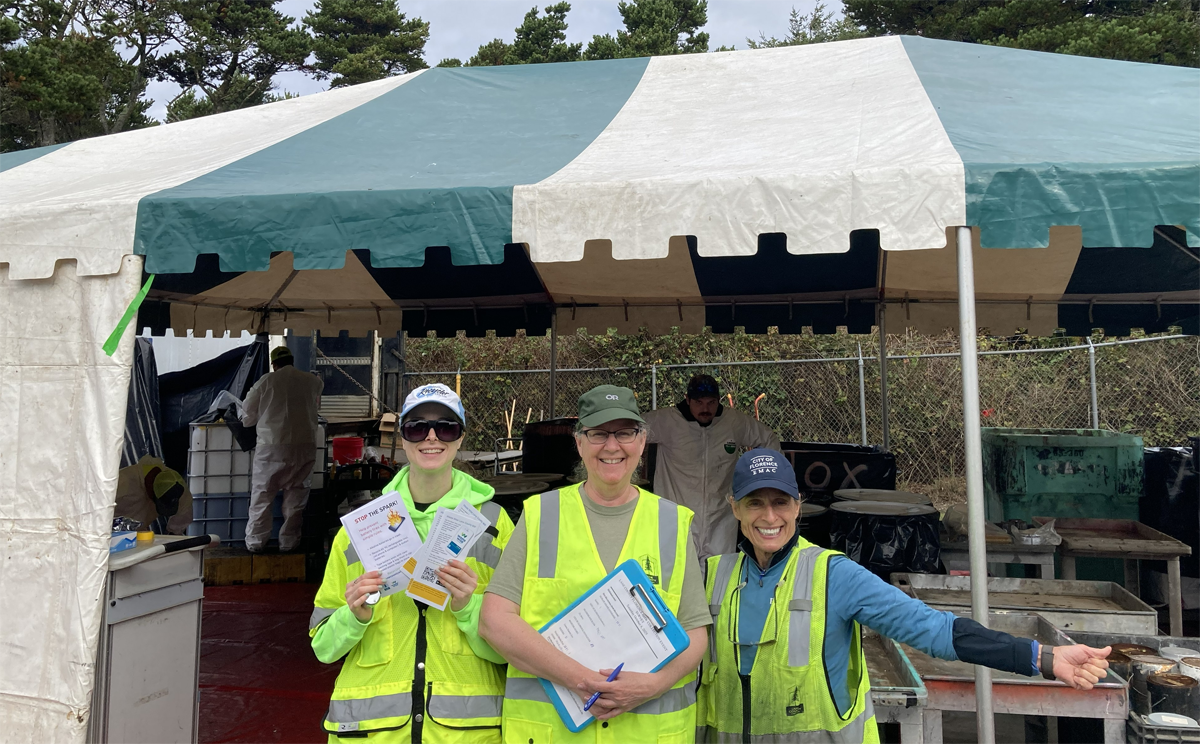Nowadays, even small towns like the one where I live have household hazardous waste drop-off events, making it easy to dispose of household hazardous waste safely and responsibly.
Most households probably contain at least a small quantity of hazardous materials like pesticides, solvents, adhesives, bleach, drain cleaners, paint, nail polish remover, motor oil, and antifreeze. Check labels for words like flammable, corrosive, poison, caution, and danger. These substances represent a significant hazard to human health and the environment.
After being collected at a drop-off event, most household hazardous wastes are recycled, reused, or burned for fuel recovery. The remainder are packaged and transported to a hazardous waste landfill.

If you are interested in learning more about household hazardous waste and why flushing it down the toilet or tossing it in the trash is a bad idea, consider reading “We Drink What We Dump – Household Hazardous Waste.”
This post is about what it is like to volunteer at a household hazardous waste drop-off event and why you might enjoy doing it.
Florence, OR Household Hazardous Waste Drop-Off Event
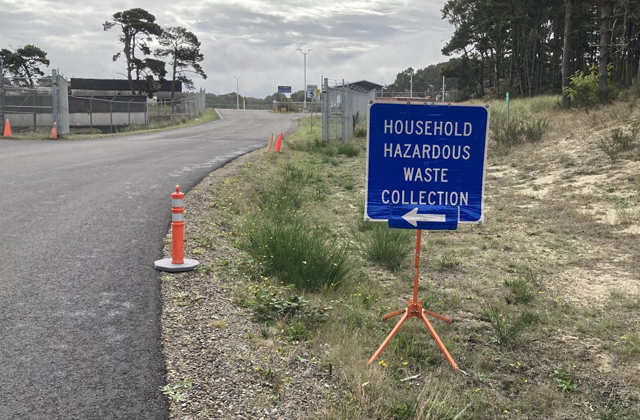
My motivation on a Saturday morning a few weeks ago was twofold. One, I am concerned about the volume of harmful substances being dumped into our air and water and onto our land, so helping out at an event that encourages people to dispose of household hazardous waste safely and responsibly appealed to me. Two, I wanted—I needed—to do something useful, no matter how small, that would allow me to set aside, for a couple of hours, how powerless I feel against what is happening in our country.
At this time of year, rain is always a possibility on the Central Oregon Coast, so I put on a raincoat before leaving the house. Our Lane County Household Hazardous Waste event was being held at the waste transfer station in town, which is where our recycling and garbage are collected before being transported to a recycling center or landfill.
When I arrived at the transfer station, the cheerful woman running the fee booth told me where to park. Later, I learned that she was a good salesperson because a number of people told me they heard about the event from her.
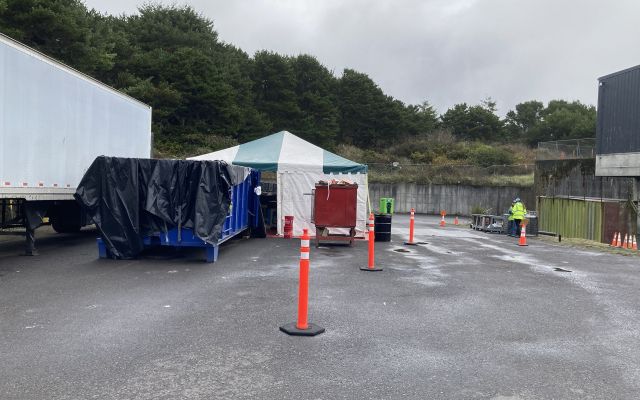
I walked back down the road to where the event was being held near the entrance to the transfer station. I was greeted by my fellow volunteers for the day, Britte and Jordan, and met the crew from Lane County Waste Management. I asked why their team didn’t have any women. The matter-of-fact reply was, “No women applied for the job.”

Beneath a canopy, a red tarp indicated the area for the professionals who are trained and certified to handle hazardous waste. This area was filled with open-topped crates and closed barrels. A metal plate had been placed across the pavement for cars to pull onto to contain accidental spills. A large roll-off dumpster was placed near the canopy to hold empty household hazardous waste containers and other trash that resulted from the event.
I donned a yellow safety vest and stood next to the metal plate, chatting with Jordan and Britte, waiting for a vehicle to show up. We discovered a shared interest in recycling and landfills, and I told them that one of my favorite books is Garbology, by Edward Hume.
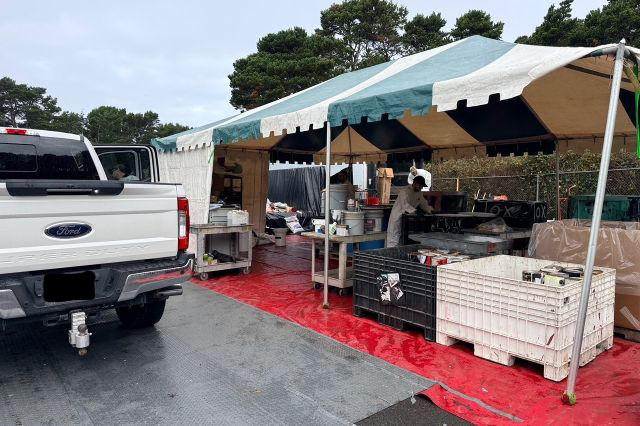
I watched Britte greet a couple of cars, and then it was my turn. Armed with a checklist on a clipboard and a counting clicker, I waved my first car forward until there was enough space behind it for the crew to place a cart and unload the contents from the vehicle.
I clicked the clicker. Next, I politely asked the driver if they were willing to share how they heard about the event (e.g., newsletter, radio, Facebook) and made a tick mark on the checklist or made a note if they had learned of the event from another source, like the local hardware store. Once everything was unloaded, I thanked them for recycling responsibly.

The crew was amazing! They carefully unloaded contents, occasionally asking questions like, “Do you know what is in this glass jar?” The team fielded questions about things like batteries, fluorescent lamps, and e-waste. Under the canopy, the crew moved in a weirdly graceful dance, sorting items into crates and pouring liquids into various drums. They kept their area tidy and organized. I am grateful to this team of people who spent a major portion of their weekend hosting our drop-off event.
I asked the crew if they would pose for a photo, and those who wished to gathered and stood still long enough for a few photos. Jake returned the favor and took a photo of Jordan, me, and Britte (see featured image at top). He told us that he had been in the Coast Guard when the Exxon Valdez oil spill occurred, devastating over 1,300 miles of the Alaskan shoreline. He and his unit were dispatched to help with the massive cleanup effort.
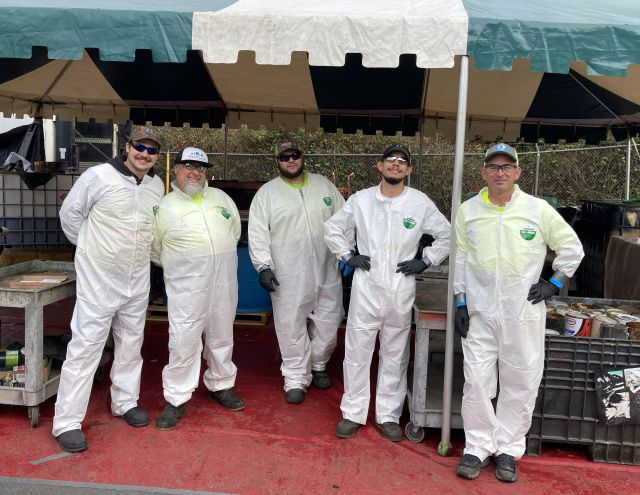
During a lull in activity, I pestered Chad, the crew supervisor, with questions. I remembered him as being one of the most interesting presenters for the Lane County Master Recycler class I took online. Chad explained that a contracted company would come by at the end of the day to transport a lot of the household hazardous waste to a specialized facility for proper handling. I learned that an event like ours costs between $15,000-$20,000. This includes staff time, travel, and overnight lodging (this is a rural area), supplies, the contractor, and transporting the trash.
Of the 25 or so vehicles I greeted (there were 221 over the 2-day event), most people were friendly and appreciative of the event. Paint was the number one item dropped off. The quantity of items ranged from one can of paint to a pickup truck bed filled with substances for woodworking. There was plenty of stuff in rusted and beat-up cans.
After my 2-hour shift was up, I thanked everyone and hiked back up the hill to my car. On the way home, I reflected on my short stint as a household hazardous waste volunteer. I met some great people and actually had fun.
Most importantly, I felt like I had been able to accomplish something worthwhile. As darkness and danger spread across our country, I often feel powerless and like I can’t actually do anything about what it going on. But that Saturday, for two hours, we collectively did something important (crew, volunteers, and participants). X amount of hazardous waste was kept out of our air and waterways, and off our land. This is a win for the environment and the people who call this place home.
So, go out and find a household hazardous waste drop-off or other event, and volunteer. It’s good for the soul.
Image Credit: Featured image at top of Jordan, Linda, and Britte (left to right) – Image Credit Jake. Image with car – Image Credit Britte. All other images – Image Credit Linda
Related Posts
- All Americans Should Visit a Landfill
- Aluminum Beverage Cans – Environmental Impact
- Are You an Aspirational Recycler?
- Composting Can Change Our Culture
- E-Waste Health Hazards and Environmental Impacts
- E-Waste – Reduce, Reuse, Repair, Recycle
- Garbology – Book Review
- Love Canal – Book Review
- Safely Disposing of Expired and Leftover Medications is Easy
- We Drink What We Dump – Household Hazardous Waste

